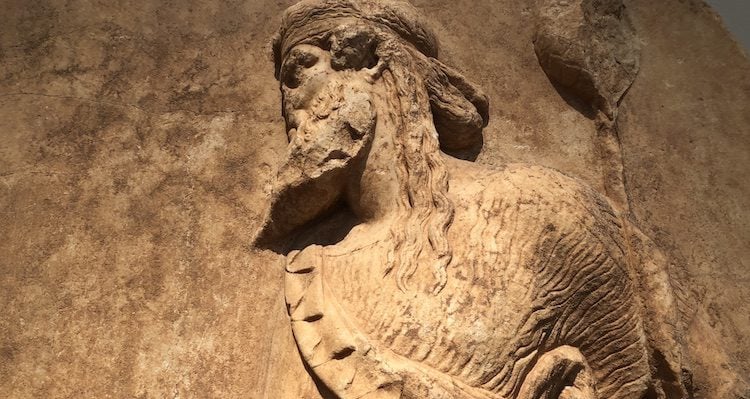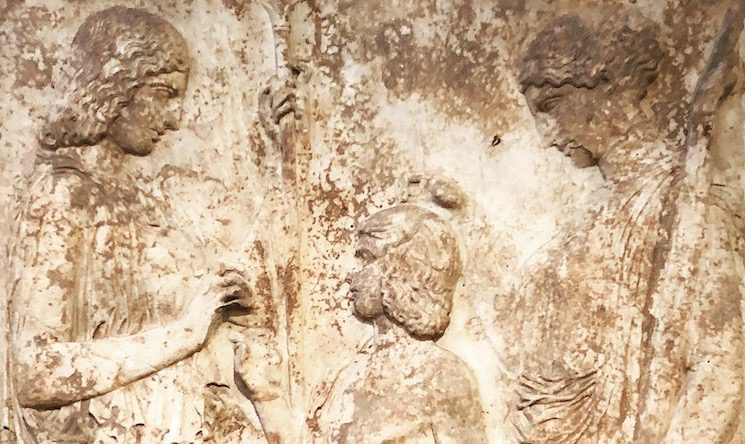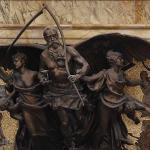Initiation rituals are probably one of the oldest forms of religious ritual among humans and could go back tens of thousands of years. In contemporary hunter-gatherer societies, initiations continue to play a large role in community life and often involve painful procedures such as the removal of teeth, circumcision, scarification, and blood letting. (1) Understandably, such forms of initiation are not common today in the Western world and have had little (if any) influence on modern Pagan practices. Much more influential have been the Greek mysteries, especially those that took place at Eleusis, a city just outside of Athens.
The Eleusinian Mysteries were the most famous set of initiation rites in the ancient world, and though it’s likely that hundreds of thousands of people participated in them over the course of nearly a thousand years, we know very little about them. Initiates were sworn to secrecy, and only rarely were those vows broken—and generally by Christians who turned their backs on their vows. But thanks to those oath breakers, as well as ancient art (especially pottery) that depicted the Mysteries, excavations from Eleusis itself, and a few poems and letters, it’s possible to at least intelligently speculate on what happened at Eleusis all those centuries ago.
Because of their secrecy, the Eleusinian Mysteries haven’t been as influential as some might wish them to be, but every time we celebrate a mystery we are, in a way, celebrating Eleusis. The modern word mystery comes directly from the ancient Greek mysterion, which means “secret rite or doctrine,” and mysterion itself derives from mystes, which means “one who has been initiated.” (2) Just saying the word mystery links us to some of the most celebrated of all ancient Pagan rites!
The mysteries of Greek and Roman antiquity were not limited to those at Eleusis. Deities such as Dionysus, Orpheus, Magna Mater, and Mithras all had their own mysteries, and unlike the Eleusinian Mysteries, those cults were portable. (The Eleusinian Mysteries could be performed only at Eleusis.) However, we know less about those rites, probably because they weren’t centrally located and were more likely to vary from location to location.

The Eleusinian Mysteries were dedicated to the grain and harvest goddess Demeter, along with her daughter, Persephone, who was known at Eleusis as Kore, which translates as “the Girl.” (3) Other deities were invoked at the Mysteries (including a form of Dionysus), but the rites revolved around Demeter and her daughter. The most famous tale of Demeter and Persephone involves the abduction of the latter by Hades, the Greek god of the underworld. In that tale, Demeter is distraught over the loss of her daughter, and her depression robs the world of its fertility. Eventually Persephone is returned to her mother, but not before eating four to six pomegranate seeds (depending on which version of the story you read). Because Persephone eats the food of the dead, she is obligated to return to that world for four (or six) months of the year. This story serves as a metaphor for the change of seasons.
It’s unknown just how large a role that story played in the Mysteries at Eleusis, but it must have been at least a small one. While Demeter was distraught over the loss of her daughter, she worked for a time as a wet nurse for the king in Eleusis, promising to establish the Mysteries there after her daughter’s return. Perhaps even more importantly, the Mysteries took place at the end of September/beginning of October.
Those of us living in the United States and Great Britain often interpret that period as a time when Persephone might be traveling to the underworld. However, in ancient Greece near Athens, crops were planted in the late fall because the summer was too hot for agriculture. (4) In other words, Persephone actually returns to her mother in the fall, and the Mysteries most likely celebrated that reunion.
One of the more intriguing bits of information about the Mysteries comes from the Christian Clement of Alexandria (150–215). In his Exhortation to the Greeks, he writes of a synthema, a word or object that brings one closer to deity and may even grant access to their power: “I fasted, I drank from the kykeon, I took out of the kiste [box], worked, placed back in the basket (kalathos) and from the basket into the kiste.” (5) Not surprisingly, Clement doesn’t offer much insight into what this all means, but it’s likely that the “work” alluded to refers to a mortar and pestle.

The mortar and pestle might have also been important in the creation of the kykeon, a barley drink associated with the Mysteries.(6) Over the last hundred years it has become fashionable to try to link kykeon with hallucinogenic substances such as ergot, a fungus that grows on grain. The problem with this is that thousands of people participated in the Mysteries every year for a thousand years, and the amount of ergot needed for such an undertaking would have been quite large. Ergot is also very unpleasant, and it’s likely the physical effects would have been commented on by writers and participants. (7)
The two biggest secrets at Eleusis likely had something to do with death and the afterlife, along with the civilizing power of agriculture. The famous orator Cicero (106–43 BCE) once wrote that the Mysteries teach “how to live in joy, and how to die with better hopes.” (8) Officiants who presided over the Mysteries had epitaphs on their headstones with statements such as “death is not only not an evil, but good.” (9) The rites themselves might have concluded with the showing of an ear of grain, the meaning of which might be related to wealth, the cycle of death and rebirth, a child, or the civilizing nature of agriculture. (This type of speculation comes from pottery, which often shows the ancient king of Eleusis holding an ear of grain while standing between Demeter and Persephone.)
Though we don’t know exactly how the Greeks interpreted the Mysteries of Demeter, it is possible to construct an outline of how they were probably enacted. Unlike most of our more modern initiation ceremonies, initiation into the Mysteries took place over several days and involved a great deal of walking. The Mysteries began in Athens, where prospective initiates had to walk through the city with a baby pig and then take that piglet down to the sea to be washed and sacrificed. This served as a method of purification for initiates and was probably a major Athenian spectacle. Just imagine several thousand people walking around with pigs in their arms! (10)

A few days after the piglet sacrifice, two processions departed from Athens to Eleusis, fourteen miles down the road. The initiation process at Eleusis was two-tiered, and the first procession was limited to past initiates seeking a greater understanding of the Mysteries. A day after their departure, the would-be initiates were allowed to walk to Eleusis. After a long walk they danced in honor of the goddesses and were finally admitted into the sanctuary. Upon admission they probably fasted, with their fast lasting until the revelation of the Mysteries the following evening.
Several different activities made up the bulk of the Mysteries, including a probable torchlit search for Persephone and an enactment of her reunion with Demeter. It’s likely that initiates were blindfolded during the search for Persephone and forced to walk what must have felt like dangerous pathways. To aid them in their search for Persephone, those returning to the Mysteries were given torches, which they most likely waved near the heads of the new initiates. While the search was under way, a priest banged a gong in the sanctuary, summoning Kore to return to the world of the living.
Eventually Persephone returned and was reunited with her mother, a spectacle that could only be witnessed by those who had returned to experience the Mysteries a second time. The reunited Persephone and Demeter, along with the second-timers, then entered Eleusis’s main sanctuary. Once in place the new initiates were free to remove their blindfolds and enter the sanctuary, which would have been awash in a sea of light from the thousands of burning torches.
After gazing upon the two goddesses (and likely a few other deities), the new initiates were ushered out of the sanctuary and the returnees were then shown an ear of grain. After the rites had ended there was probably feasting, merry making, and perhaps a few consensual orgies.
Due to the madcap energy present at the Mysteries, it’s likely that every initiation experience differed from person to person. The blindfolds, the exhaustion, the fear from the fires—all of this must have had a transformative effect on the psyches of those involved. I’m sure the priests who led the Mysteries had their own interpretations of the meaning of everything, but the meanings that mattered most were those gleaned by the participants—and that’s a truth that still applies to the mysteries of initiation today.
Adapted from the book Transformative Witchcraft: The Greater Mysteries, Llewellyn Publications, 2019. You can purchase Transformative Witchcraft at most major booksellers and your local Witch-shop. The link above will take you to Llewellyn’s site. If you must buy it on Amazon, that link is here.
I’m really proud of this book, and hope you might consider picking it up. I share more of the book in this article on The Witches’ Pyramid.
All images by me, and were either taken at Eleusis or the National Archaeological Museum in Athens.
NOTES
1. Hayden, Brian Shamans, Sorcerers, and Saints, Smithsonian Books, 2003, pages 103–104.
2. Online Etymology Dictionary, https://www.etymonline.com/word/mystery
3. Burkert, Walter, Greek Religion, Harvard University Press, 1985, page 159. Other books sometimes translate Kore as “the Maiden.”
4. Bowden, Hugh, Mystery Cults of the Ancient World, Princeton University Press, page 28. There are many smart people who disagree with this interpretation.
5. Burkert, Greek Religion, page 286.
6. Ibid., 286.
7. Burkert, Ancient Mystery Cults, Harvard University Press, 1987, page 108
8. 100. Ibid.
9. 101. Ibid.
10. This entire summary of what happened at the Mysteries comes from Hugh Bowden’s Mystery Cults of the Ancient World, pages 32–42. Bowden’s account is extremely readable, a quality that can be challenging to find when mucking around in ancient history.



















